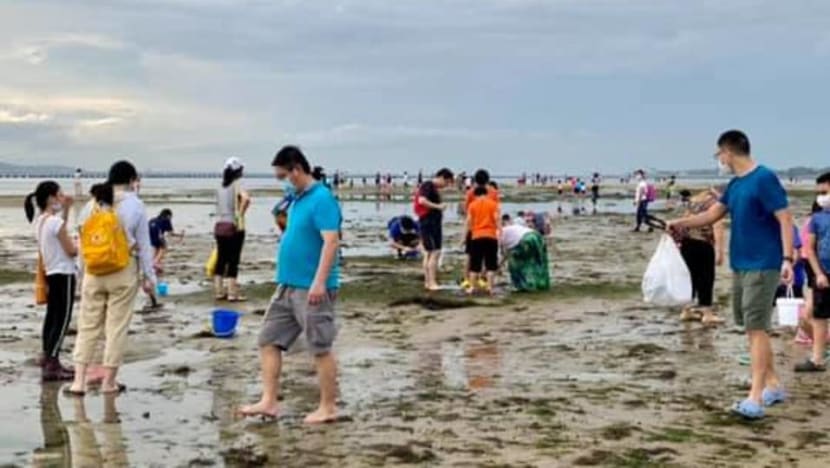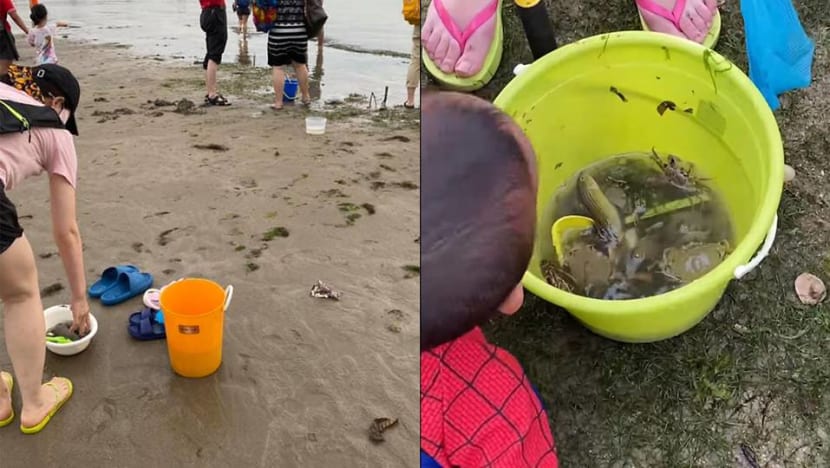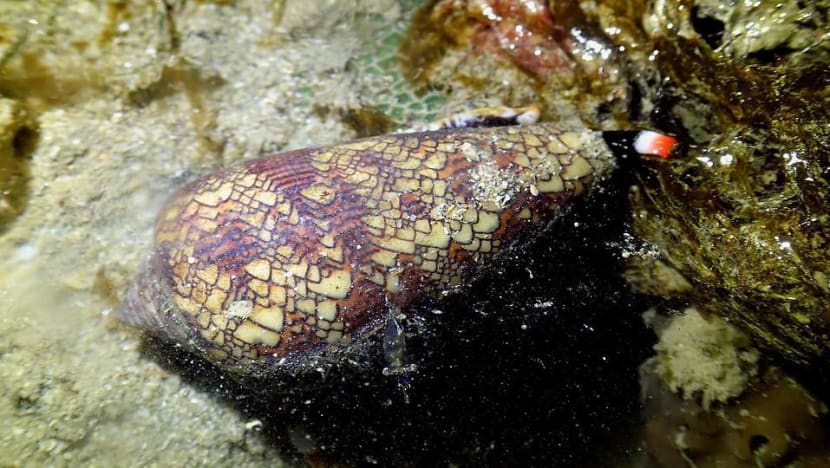Commentary: Excitement over marine creatures is great, but are we loving Singapore’s shores to death?
High visitorship to intertidal zones suggests growing interest in Singapore’s marine creatures, but without deeper understanding of their ecology, we could be causing them harm, says NUS’ Dr Zeehan Jaafar.

Visitors to Changi Beach were seen picking up sea creatures and collecting them in pails. (Photo: Daphne Ting)
SINGAPORE: Social media platforms were abuzz in late May with photographs of fan clams, reported to be in the hundreds, in rotting piles strewn along Changi Beach.
These clams, buried with only their tips jutting out of the sand when alive, were all cracked open, and their abductor muscles were harvested – likely for consumption.
In early June, reports emerged of dozens of beach goers allegedly collecting marine organisms with metal tongs, spades, and rakes at Changi Beach.
Over the last weekend of June, photographs were posted online of barefooted beachcombers holding up a horseshoe crab by the tip of its tail at Sembawang Beach.
What accounts for the sudden interest in the creatures that dwell in our seas? Some want to consume them as food, while others are curious about these animals and yet others want to collect them for their home aquaria.
READ: Commentary: Malaysians in lockdown coo over pictures of returning wildlife – but there’s more than meets the eye
COASTAL FORAGING IS AN ACTIVITY AS OLD AS TIME
Unable to travel due to the pandemic, those seeking an outdoor nature-focused activity during the school semester break were likely inspired by several YouTube videos and blogs that showcased harvesting with metal tools along the shores of Singapore.
Singapore experiences two high tides and two low tides a day. During the low tide, a portion of the seabed area is exposed, revealing sandflats and mudflats otherwise under water.
The collection of organisms from our shores is not a novel phenomenon. Earlier inhabitants of our island scoured intertidal areas to forage for clams, snails, sea cucumbers and crabs to supplement their meals.
But over the years, Singapore faced significant losses of natural marine habitats resulting from land reclamation and coastal urbanisation. Today, approximately 30 per cent of coral reef and 1 per cent of mangrove areas remain.
We must question then if the indiscriminate collection of native biodiversity is sustainable.
HIGH VISITOR PRESSURE
The negative impact of high visitorship to the intertidal zone is a cause for concern. In addition to the flora and fauna that are easily observable, there exists myriad organisms living within the substrate that are not.

These organisms – typically small worms, crustaceans and molluscs – burrow in the substrate and are collectively termed “infauna” or “endobenthos”.
The impact of human trampling to the intertidal area varies with the intensity and frequency of visitorship. The in-fauna community, such as soft-bodied marine worms, are especially susceptible to trampling.
Studies have found that high human footfall can reduce algae and seagrass cover, crucial as food and shelter to marine organisms.
Dugongs, for example, are herbivorous marine mammals that feed on specific seagrass species. The seagrass meadows along the coastline of Changi Beach are known feeding sites for this species. Changes to the seagrass meadows can therefore have vast implications for the organisms that depend on them.
Persistent trampling over the long term has been found to significantly change the characteristics of intertidal areas, and negatively impacts their resilience and ability to recover from other threats.
READ: Commentary: The ocean is changing – it’s getting more acidic
LIMITED PROTECTION FOR MARINE CREATURES
While there has been an increase in public discourse on intertidal plants and animals, there is limited legal protection afforded to the vast diversity of organisms and to the majority of our coastal areas.
Even though wild animals are protected under the Wildlife Act which came into force in June 2020, most invertebrate organisms, including many of these marine critters, are exempt. Furthermore, only a fraction of our coastline is protected or designated as reserve areas.
READ: Commentary: Cute otters and pangolins get saved but are ugly animals a lost conservation cause?
Yet the passing of legislation is not always the most effective approach because of the inbuilt punitive measures. The legal process to formalise specific bills take many months, so might not be adequate as a ready-to-apply solution. Once the legislation is in effect, enforcement can be challenging.

The ideal scenario is for users of common resources, such as intertidal areas, to collectively understand the consequences of non-civic actions. To safeguard our shores, it is far more effective for users to arrive at a consensus on key principles to steer future interactions.
This idea for collective responsibility towards the conservation of our marine and coastal areas was also suggested in the Singapore Blue Plan 2018 – a ground-up initiative by over 120 contributors and 14 stakeholder groups.
This plan included recommendations to the Government for the protection of identified marine areas, enhancement of the legislative framework and the implementation of long-term monitoring programmes.
READ: Commentary: Do we need to do more to protect our community cats?
VISITING OUR SHORES RESPONSIBLY
Intertidal zones are responsible for coastal protection and offer recreational, cultural and spiritual spaces that contribute to our national identity.
Increased visitorship to our shores signals their importance to our well-being within our urban lifestyles.
Agencies responsible for these resources have demonstrated their cognisance of this. For instance, in response to the surge in visitors to Changi Beach, the National Parks Board (NParks) will put up signs and increase staff and volunteer presence at intertidal areas, rather than closing the shores or limiting public access.
READ: Commentary: The awkward adventures of a Singaporean urbanite in a city in nature
Another way in which people can enjoy these creatures is to learn about the biodiversity of our intertidal areas and how to appreciate them safely when we visit.
We can do that by joining organised walks by the NParks and volunteer groups such as Naked Hermit Crabs and Young Nautilus. These are carefully planned to help one prepare to responsibly visit intertidal areas while maintaining safety.
Observe their behaviours and photograph organisms you encounter, but do not attempt to touch or handle them because many marine creatures bear sharp spines or are venomous.

For those who want to explore intertidal areas themselves, resources on recommended attire and conduct, and on the flora and fauna they might come across are available on the websites of NParks, Celebrating Singapore’s Shores, and WildSingapore.
Exhibits such as the Human x Nature at National Library and the Lee Kong Chian Natural History Museum are also excellent places to learn more about native biodiversity and the socio-cultural elements of nature.
ADVOCACY FOR OUR SHORES THROUGH RESPECTFUL DISCOURSE
Communities of nature enthusiasts are also becoming very popular. There are groups dedicated to clean-up sessions or hiking. On Facebook, groups were also started for specific areas such as Pasir Ris and Sisters’ Islands Marine Park, where visitors post photographs of their excursions.
The Friends Of The Parks networks spearheaded by NParks allows for volunteers to get involved in all kinds of community activities and in managing their favourite parks.
READ: Commentary: Let Singapore’s green spaces grow wild
As residents in this small island, we recognise the immense pressure we subject our limited natural spaces to. The maturity in public discussions that unfolded in past weeks relating to the collection of intertidal organisms was heartening to observe.
Although views were at times different, the discourse remained respectful. If we continue on this trajectory, we will be able to channel our passion towards active engagement for nature-related issues, and advocacy for blue and green spaces in Singapore.
Zeehan Jaafar is a Lecturer at the Department of Biological Sciences, National University of Singapore and the Lead Editor for the Singapore Blue Plan 2018.














